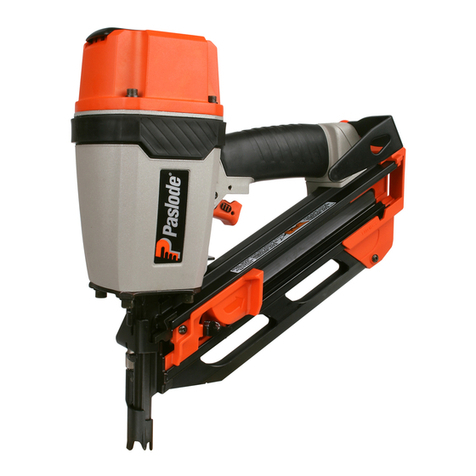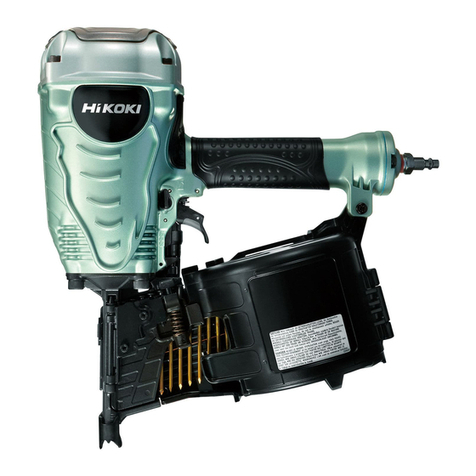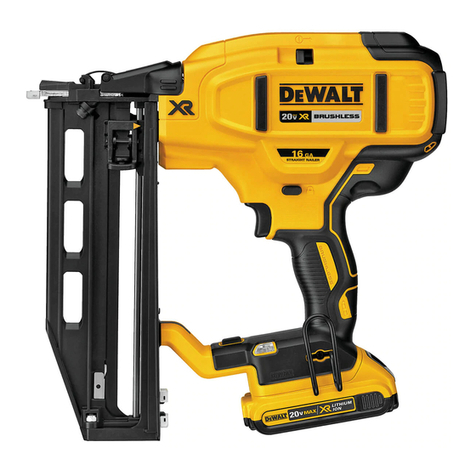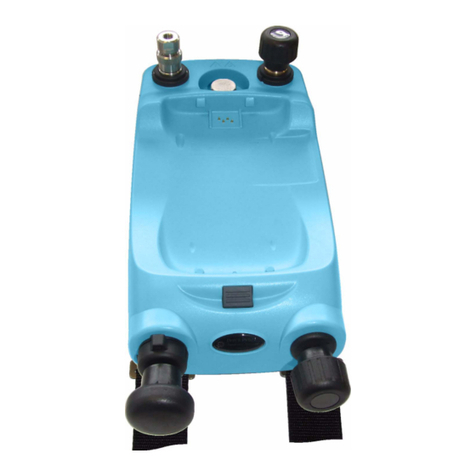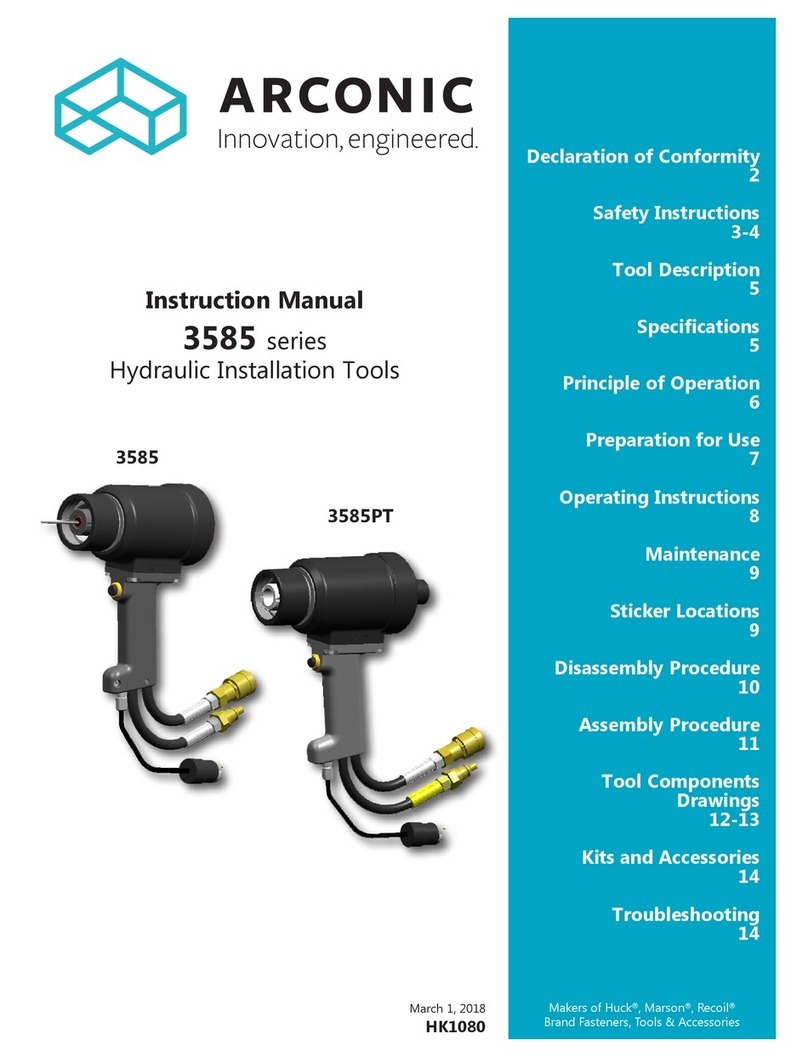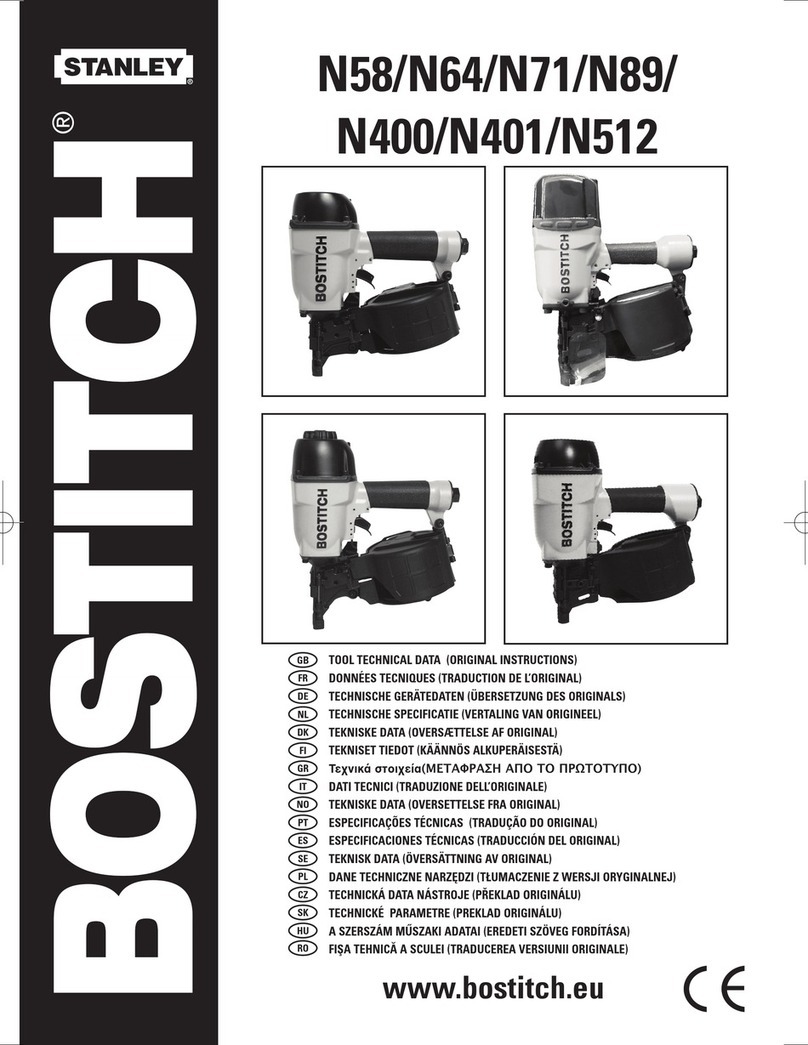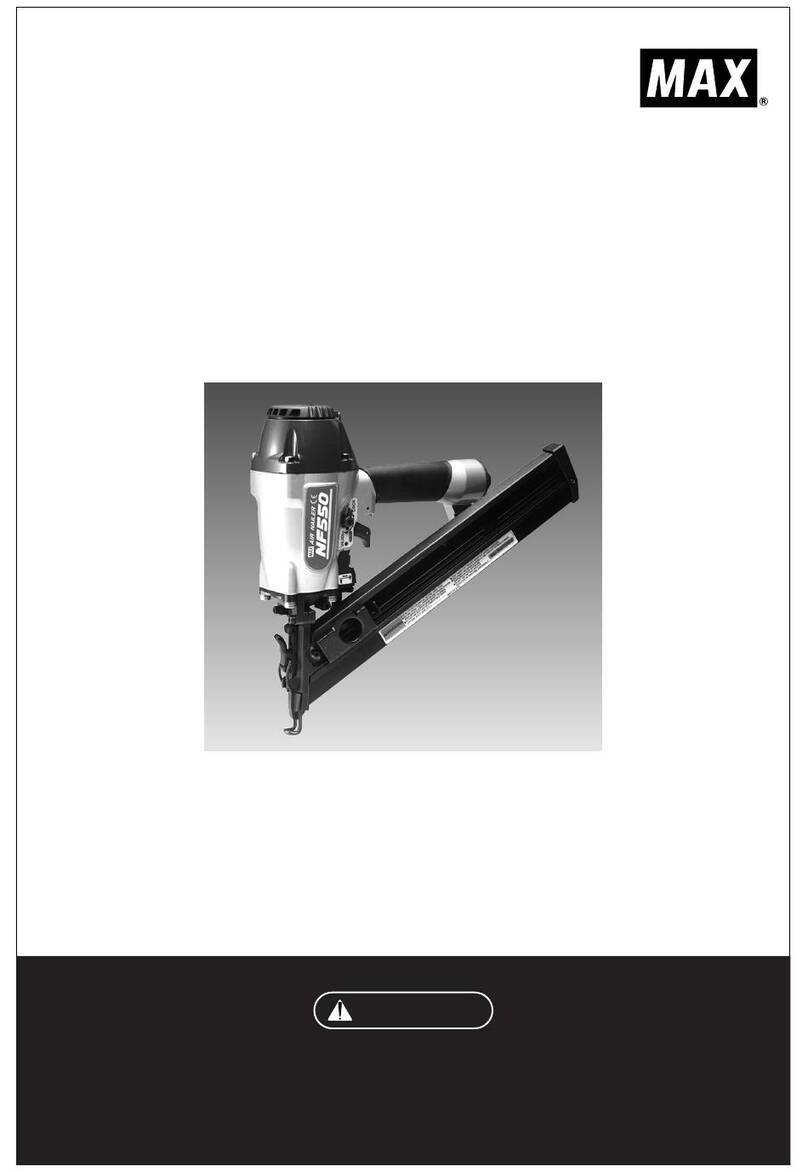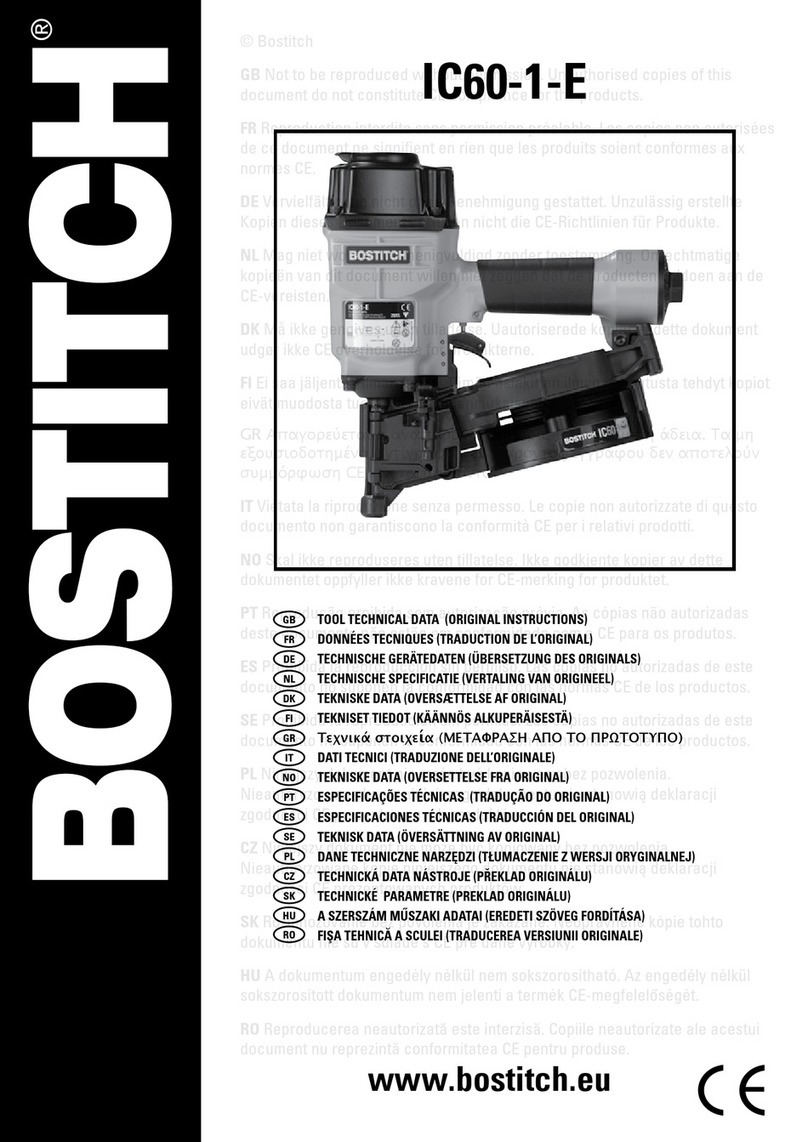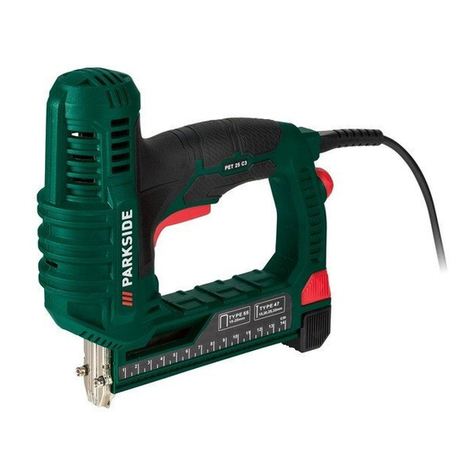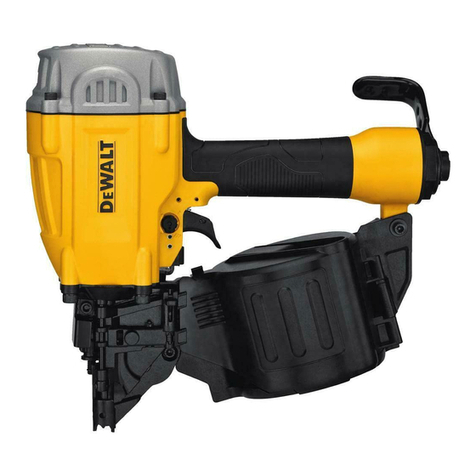Mantis RCS ELIMINATOR NSDPP38/40 User manual

THE RCS ELIMINATOR™
Operation Manual
NSDPP38/40RCS
POINT LOCATOR™
BALLISTIC NAILSCREW® DRIVER
www.suredrive.com
sales@suredrive.com
East: 866.767.1850
Conover, NC
West: 888.219.1700
Hayward, CA

IMPORTANT
It is very important that the intended operator of this tool
Reads and understands this manual before operating this tool.
EC Machinery directive EN 792-13
ANSI SNT – 101
90 DAY LIMITED WARRANTY
PARTS & SERVICE DEPARTMENT
http://www.elder-hayesinc.com or call 1-800-769-0775
(ONLY USE PARTS AND ACCESSORIES RECOMMENDED BY THE MANUFACTURER)
Contents:
1. Important safety instructions 4.Maintenance
2. Compressed air system 5.Troubleshooting when due to damage
3. Operating instructions
Supplier details: This tool is specially designed with the EZ Slide to be
used to install the Ballistic NailScrews® at a 45° angle through a
Sure Drive USA MANTIS™ 345, 385, 396, or TRX Clip. For more
information, call Sure Drive USA at 866-767-1850.
Sure Drive USA MANTIS™
Clip 345 385 396 TRX
Groove
Height .353” +/- .025” .380” +/- .025” .406” +/- .025” .396”
Groove Depth .400” - .500” .400” - .500” .400” - .500” .270” +/- .025”
Profile
Installation Videos At: www.suredrive.com or www.HowToNailScrew.com
The lowest installed cost with the fastest installation s
p
eed is the name of the
g
ame!

Decking Material Reference Chart
Composite Manufacturer 396
Clip 385
Clip 345
Clip TRX
Clip
Hidden
Link Shadoe
Track Groover +
Mantis Clip
Composite Manufacturer 396
Clip
385
Clip
345
Clip
TRX
Clip
Hidden
Link Shadoe
Track Groover +
Mantis Clip
AERT
Wolf Deck
MoistureShield
Island Collection
ChoiceDek
Grooved PVC
Modern View
Gossen/WeatherReady
Evernew
American Classic
LT
Trailways
Fiberon
Passport
Horizon
Deceunick
Pro-Tec
Solstice
Professional
Clubhouse
Veranda
Kleer
Latitudes (UFPI)
Coastal
Captiva
Sierra
Capricorn
Tuf Board
Koa
Alsek
The Wave
Bellus
Nature’s Composite
Cierra
Style Selections
ECO
Premium Composites
Kinbo
Medallion Impressions
Royal/Century
Medallion Prestige Series
Royal Deck
Medallion Prestige Plus
Non Grooved Composites
Rhino Deck
Evergrain
Armadillo
Non Grooved PVC
Original
AZEK
TimberTech
Endeck
Evolutions
Everew PT
XLM
Fiberon Outdoor Flooring
Twin Finish
Patwin
Terrain
TufDek
Trex
WOLF Deck PVC
Transcend
Zuri
Enhance
Alternative Decking
Select
NyloDeck
Accents

1. Important Safety Instructions
This manual should be read carefully and understood completely by any person who intends to operate this
tool. All instructions given should be adhered to accordingly as failure to comply may result in serious
damage to the operator and/or the tool. The employer is responsible for enforcing the use of safety protection
equipment by the tool operator and all other personnel in the work area.
Use safety glasses: all persons in the work area must always wear safety glasses in order to prevent eye
injuries.
Ear protection must also be worn to prevent a possible hearing loss.
Use clean dry regulated compressed air at the recommended pressure (given in the technical data).
Use only fasteners made or recommended by the tool manufacturer (refer also to the technical data).
Never exceed the maximum recommended operating pressure of this tool.
Never use oxygen, carbon dioxide, combustible gases or any bottled gas as a power source.
Always disconnect the air supply when doing any tool maintenance, cleaning a jam, moving location,
leaving the work area or passing the tool.
Regularly inspect the safety, the trigger and the springs for free unhindered movement, never use a tool
that requires servicing.
Connect the male free flow nipple to the tool side of the airline so that the tool is depressurized when
disconnected from the hose.
Never load fasteners with the trigger safety depressed as if the safety is bumped it will result in a fastener
being fired.
Never carry the tool with the safety depressed as if the safety is bumped then it will result in a faster being
fired.
Never point the tool at yourself or at any one else.
Never fire a fastener into a hard brittle surface such as concrete, steel or tiles.
Do not drive fasteners too close to an edge or at too great an angle as the fastener may fly free or ricochet
causing personal injury and damage.
Always ensure that the work area is amply lit so as to avoid possible accidents caused by bad light.
Never remove, tamper with or otherwise cause the tools operating controls to become inoperable.
2. Compressed Air System
Proper use of the fastener driving tool requires an adequate quantity of clean dry compressed air. All
compressed air contains moisture and other contaminants detrimental to the tool and so it is recommended to
use an airline filter regulator lubricator as close to the tool as possible (within 15 feet (4.5m)). The filter
should be well maintained so as to ensure optimum performance and power. All parts of the air supply
system should be clean and contaminant free.
The tool shall only be connected to a compressed air line where the maximum allowable pressure cannot be
exceeded by a factor of more than 10%, which can for example be achieved by a pressure reduction valve
which includes a downstream safety valve.
A male free flow coupling should be connected to the tool side of the system with the female coupling
providing a seal to prevent air loss from the compressor tank upon disconnection. Never connect a female
disconnect coupling to the tool side as this provides a seal which prevents loss of compressed air from the air
tank and if connected to the tool it could seal a charge of air in the tool which could lead to an unintentional
actuation. Do not mount a swivel connector in the air supply line.
Different work pieces will require different operating pressures, the harder the wood the greater the pressure
required. Remember always use the lowest pressure required for the work process at hand, this being to
prevent unnecessarily high noise levels, increased wear and resulting failures.
WARNING Keep hands and body away from the discharge area of the tool when connecting the air supply and
always disconnect the tool when servicing, adjusting, cleaning and when the tool is not in use.

3. Operating Instructions
3.1 Loading Fasteners (refer also to the technical data)
1. Load the fasteners into the end of the magazine.
2. Press the latch mechanism and pull back
to the last BNS in the strip and release.
3.2 General Operating Instructions
3.2.1 Types of Actuating and Triggering Systems.
For tools without a contact safety:
Single Sequential Trip fire :
Fasteners can only be fired by first activating the contact safety(by holding the tool against the work
piece) and then by squeezing the trigger, thereafter any further driving operations can only be actuated
after the trigger has been returned to the starting position. The sequential trip tool allows exact fastener
location without the possibility of driving a second fastener location without the possibility of driving a
second fastener due to recoil.
3.2.2 Operating Procedures
Protective equipment: Before using any tool always ensure that you and those in the work area are using
the appropriate working equipment
Firing a fastener: To fire a fastener hold forks on the nose of the tool against the clip, if the tool has a
contact safety it will be necessary to push the tool forward so as to depress the safety, following which
squeeze the trigger to fire a fastener.
Do multiple test runs with scraps of the actual materials that you intend to use before starting
the deck (until the desired set is achieved).
Exhaust Air: each time a fastener is driven a blast of air is exhausted from the top front area of the tool,
keep your face clear of this, some tools incorporate a 360 exhaust, which enables you to control the
direction of the exhaust gases.
Depth Control: check whether the fastener has been driven into the work piece in accordance with the
requirements, the driven depth can be controlled by adjusting air pressure only.
Drive fasteners tight, but do not over drive or you will deform the clip.
90 to 100 PSI is
recommended.
Always use the lowest possible air pressure for the following reasons:
- Save energy
- Less noise will be produced
- A reduction in fastener driving tool wear will be achieved

The new UFO NSDPP38/40RCS installation tool drives a UFO Ballistic NailScrew
®
(BNS) in like a
nail and can be removed like a traditional #1 SQ Robertson
®
drive screw.
The operator needs to perform only three easy steps:
1. Drop the Mantis™ Clip™ into the EZ Slide. The clip should be
loaded where you can read the name Mantis™ on the back. The
raised portion (tab) of the clip will be to the front of the slide.
The slide has a magnet to keep the clip from falling out.
2. Place the RCS Eliminator™ flat on the
joist and push forward. Pushing the tool
forward slides the base of the Mantis™
clip under the decking material. The tab
of the clip should slide into the groove.
Make sure the forks of the tool are holding
the Mantis™ Clip tight. You should see
the clip align with the deck board and fit snug.
3. Pull the trigger. UFO Ballistic NailScrews® (PPN150)
PTPPNS112113SQB, PTPPNS214113SQB,
SSPPNS112113SQB (Stainless Steel), & PLNS112113SQST
(Full Thread for Steel) are available in carbon or stainless steel
with a black PPG1500™ E Coat. These NailScrews
®
can also be
used in other 34° tools and with other clip systems.
Any defective or improperly functioning tool must be immediately
disconnected from the compressed air supply and passed to a
specialist for inspection.
3.3 Precautionary Measures
- Always assume that the tool contains fasteners.
- Remove finger from the trigger when not driving fasteners. Never carry the tool with your finger on the
trigger, as the tool will fire a fastener if the safety is bumped.
- Keep the tool pointed in a safe direction at all times, never pointing it toward yourself or others whether
it contains fasteners or not.
- Never attempt, to drive a fastener into material that is too hard, or at too steep an angle or near the edge
of the work piece, the fastener can ricochet causing personal injury. Remember, always hold nose right
up to and firmly against the work material.
- Disconnect the tool from the air supply before performing any maintenance, leaving the work area,
moving the tool to another location, or handing the tool to another person.
- Always, disconnect the tool before clearing any jams. To remove a jam just remove the driver guide
cover plate or if applicable open the quick release and remove the obstructing nail.
- Carefully check the tool for proper operation of trigger and safety mechanism. Do not use the tool unless
both the trigger and safety mechanism and any other of the operating control are functional or if the tool
is leaking air or needs repair.
- Written approval of the tool manufacturer must be obtained prior to making any modifications to the
tool.

4. Maintenance
Important: Clean and inspect your tool every time you use it.
The employer and tool operator are responsible for assuring that the tool is kept in safe working order.
Furthermore only service personnel trained by the manufacturer, distributor, or employer shall repair the tool.
CAUTION: Always remove the air supply before commencing any cleaning or inspection and remember to
correct all the problems before beginning any repair work.
Wipe tool clean and inspect tool for wear or damage. Use non-flammable cleaning solutions to wipe the
tool. Never soak the tool in these solutions as they can cause internal damage.
Always ensure that all of the screws are kept tight as loose screws can cause injury or can damage the tool.
Tools requiring lubricant: If the tool is used without an in line lubricant then be sure to put in about 3
drops of lubricant at the start of each workday and 3 drops for every 1,000 fasteners fired thereafter.
Tools shall be repaired or equipped only with parts or accessories that are supplied or recommended by the
tool manufacturer / supplier.
NEVER use a tool that requires repair work.
5. Troubleshooting and Counter Measures
Failure Possible Causes Check Method Counter Measures
No nail
is ejected
Nail
Incorrect nails are
loaded
Abnormal nails are
loaded (large-sized
head ,bent
Incorrectly chained,
etc.)
Check if
recommended nails
are loaded
Use recommended nails
Remove abnormal nails
and load normal nails
Magazine Unit
Push lever
Defective nail
feeder(deflected, bent
or broken)
Defective feed spring
(worn or broken)
Check for
abnormalities of nail
feeding portion
(deflected, worn,
deformed broken)
Repair deformed parts
Replace defective parts
Narrow or wide width
of the Magazine
groove
Worn nail head
supporting portion of
Magazine Abnormal
nail guide groove of
Blade Guide
(deflected, deformed or
broken)
Load nails and
confirm that they will
move smoothly

Failure Possible Causes Check Method Counter Measures
No nail
is ejected
Adhesive fragment or
wood dust sticking on
the Magazine or nail
feeder
Remove adhesive
fragment or wood
dust
Push leve
r
Check push lever
movement
Replace
[Output unit: Piston or
driver]
Air pressure too low
Carry out idle driving
and check the return
of the driver blade
Check compressor
Worn piston ring Replace piston ring
Defective piston
bumper
Replace the piston
bumper
Defective bumper piece
(defective, worn or
broken)
Replace the piece
Defective O-ring
(disconnected,
deformed or broken)
Reassemble or replace
the O-ring
Defective driver blade,
(deflected, deformed or
broken)
Replace
Defect inside cylinder
(adhesive or wood
fragment, worn)
Check if the nailer
drives at minimum
operating pressure
Remove adhesive
fragment or wood dust

Failure Possible causes Check Method Counter measures
The driven nail is bent Nails are inaccurately
fed into the Blade
Guide
Incorrect nails are
loaded
Refer to item above Refer to item above
Worn driver blade
Check if the driver
blade is extremely
worn or not
Replace the driver
blade
The wood is too hard
Check if the nails
bend on softer wood
or not
Stop using the tool
The driven nails do not
fully penetrate the work
piece (heads protrude)
The wood is too hard Stop using the tool
Air pressure too low Adjust the air pressure
Worn or broken driver
blade
Carry out idle
driving and check if
the driver blade
protrudes from the
blade guide nose
Check if the tip of
the driver blade is
excessively worn or
not
If the driver blade does
not protrude from the
blade guide replace
Incorrect driving depth
adjustment
Adjust the guide plate to
the appropriate position.
Defective piston ring
(worn or broken)
Defective inner surface
of cylinder (worn or
rough)
Disassemble the output
unit and check the
inside and outside
surfaces of the piston
ring and cylinder
Replace the defective
parts
Nails clog within the
ejecting gate
Nails are inaccurately
fed into the blade guide
Incorrect nails are
loaded
Refer to first item Refer to first item
Use designated nails
Worn tip of the driver
blade
Carry out idle driving
and check if blade tip
if worn or not
Replace
Worn guide groove of
the blade guide
Check the wear of the
blade guide
Replace
Work piece material is
too hard Stop using the tool

The RCS Eliminator (NSDPP38/40RCS) Part List
ITEM PART # PART’S DESCRIPTION ITEM PART # PART’S DESCRIPTION
101 920800 DEFLECTOR PAD 401 920828 O - RING
102 920801 DEFLECTOR 402 920829 O - RING
103 830612 O - RING 403 920830 BASE
104 920502 HEX.SOC.HD.SCREW 404 920831 SPRING
105 920803 HEX.SOC.HD.BOLT 405 920860 NOSE PIECE
106 920805 SPRING RETAINER 406 920833 BOLT ASSY
107 920849 CAP 407 920834 BOLT ASSY
108 920806 PACKING 408 920835 SAFETY GUIDE
109* 920850 COMPRESSION SPRING 409 920836 SAFETY SPRING
110* 920851 SEAL 410 920837 SAFETY
111* 920852 O - RING 411 920365 HEX.SOC.HD.BOLT
112 920853 HD.VALVE PISTON 412 920324 HEX.SOC.HD.BOLT
113* 920854 O - RING 413 920838 HALF ROUND HD.HEX.BOLT
114 920813 PRESS RING 414 841563 MAGAZINE A
115 920882 CYLINDER PRESS RING 415 920168 LOCK NUT
116* 920855 O-RING 416 841564 POSITIONING SHEET
117 841562 DRIVER UNIT 417 920333 HALF ROUND HD.HEX.BOLT
118 920817 O - RING 418 920348 LOCK NUT
119 920857 CYLINDER 419 920370 STOP NAIL PLATE
120 920819 CYLINDER RING 420 920346 PROTECTING HOOD COVER
121 920820 CYLINDER SPACER 421 841565 STEEL CHANNEL
122 920821 O - RING 422 920843 SAFETY STOPPER
123* 920822 BUMPER 423 920340 PROTECTING HOOD COVER
124* 820569 COLLAR 424 920336 PUSHER
201 920519 O - RING 425* 920844 SPRING
202 920521 O - RING 426 920845 ROLLING ELEMENT
203 920520 PLUNGER CAP 427 920846 ROLL PIN
204 920523 VALVE PLUNGER 428 920339 SPRING
205 920522 O - RING 429 841178 HALF ROUND HD.HEX.BOLT
206 920524 O - RING 430 920861 HEX.SOC.HD.BOLT
207 920525 SPRING 431 920572 FLAT WASHER
208 920823 PLUNGER 432 920862 LATCH SPRING BUSHING
209 920526 O - RING 433 920573 BOLT CAP
210 920528 TRIGGER VALVE HEAD 434 810803 PULL SPRING
211 920529 SPRING PIN 435 841566 HEX.SOC.HD.BOLT
212 920824 SPRING PIN 436 841567 FLAT WASHER
213 920530 SPRING PIN 437 841568 POSITIONING SHEET
214 920825 SPRING 438 841569 GUIDE BLADE HOLDER
215 920826 TRIGGER UNIT 439 841570 GUIDE BLADE HOLDER
301 920752 GUN BODY UNIT 440 841571 NUT
302 920539 END CAP 441 841572 NUT
303 920540 O - RING 442 841573 HALF ROUND HD.HEX.BOLT
305 830640 AIR PLUG 443 920748 MAGNET
(ONLY ON SOME MODELS)
For Parts and Service: http://www.elder-hayesinc.com or call 1-800-769-0775

NSDPP38/40RCS
For Parts and Service: http://www.elder-hayesinc.com or call 1-800-769-0775
Table of contents
Popular Nail Gun manuals by other brands
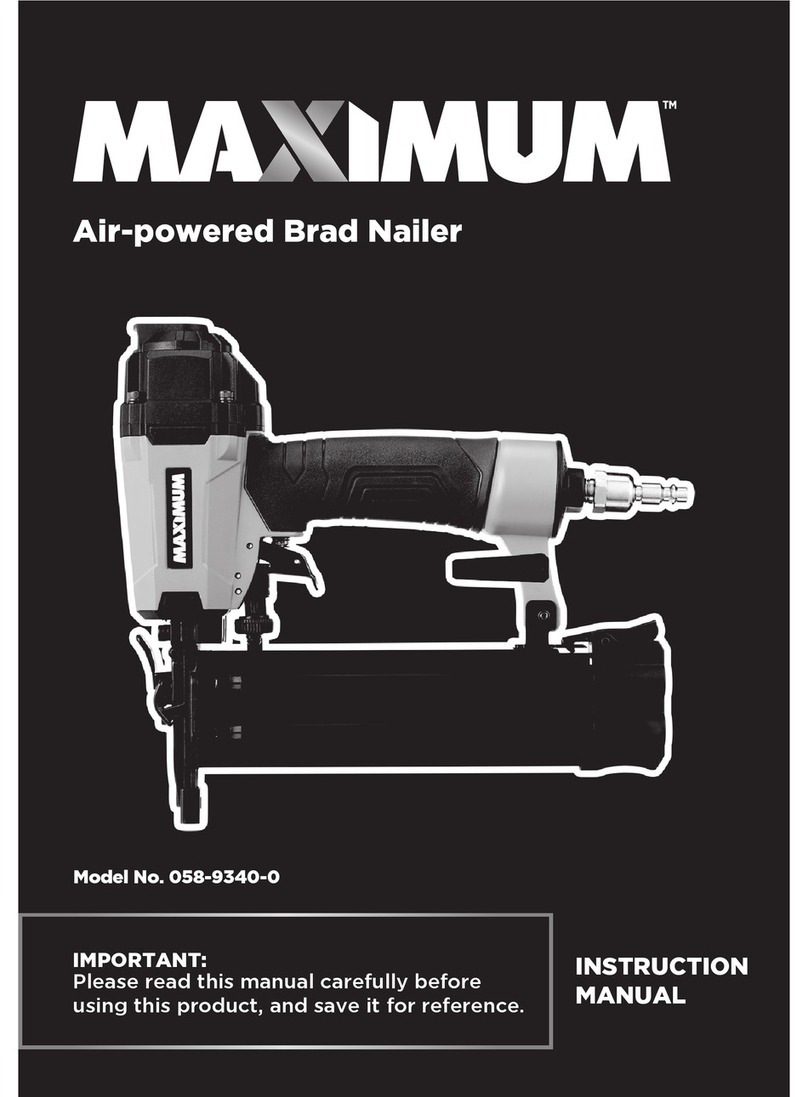
Maximum
Maximum 058-9340-0 instruction manual
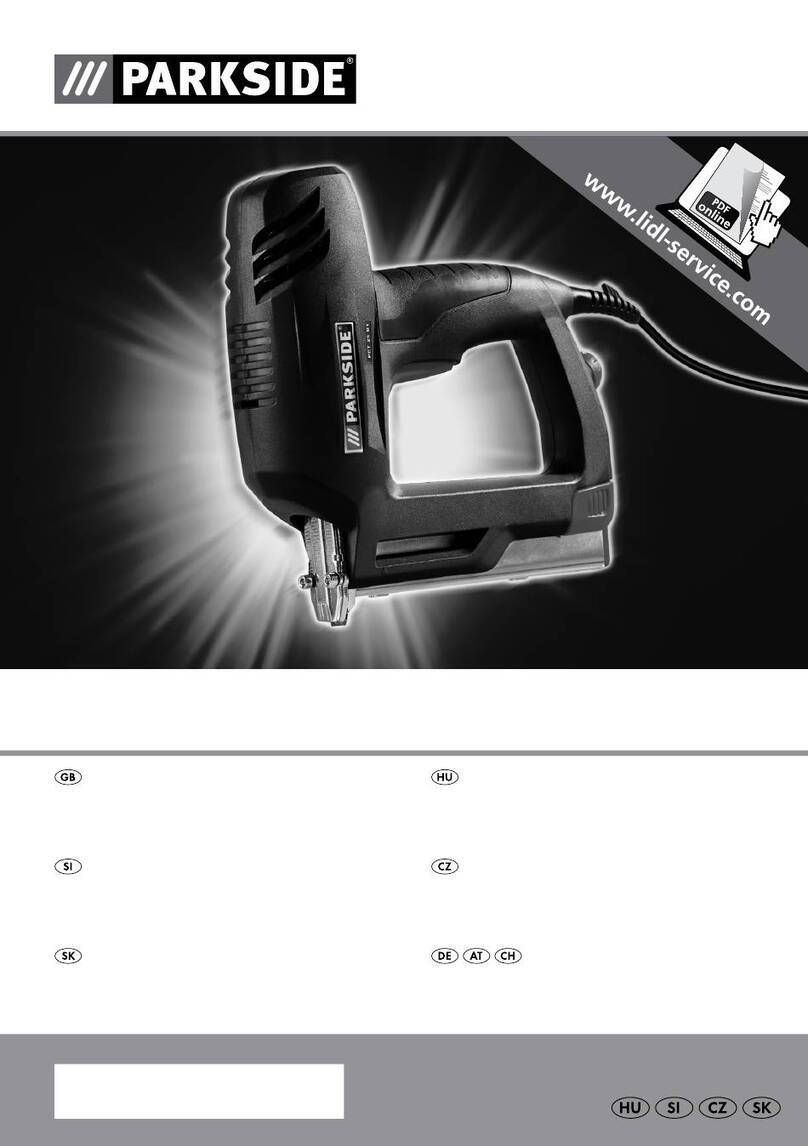
Parkside
Parkside PET 25 B1 Operation and safety notes
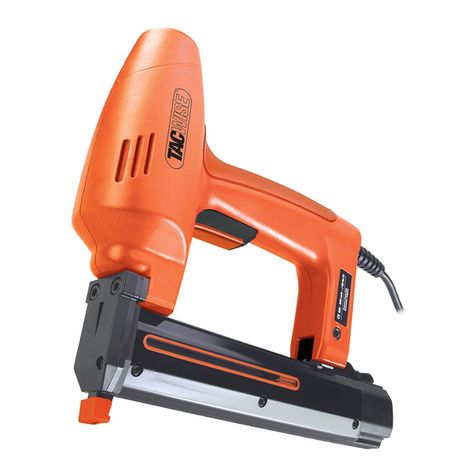
tacwise
tacwise Master Nailer 191EL PRO Operator's manual
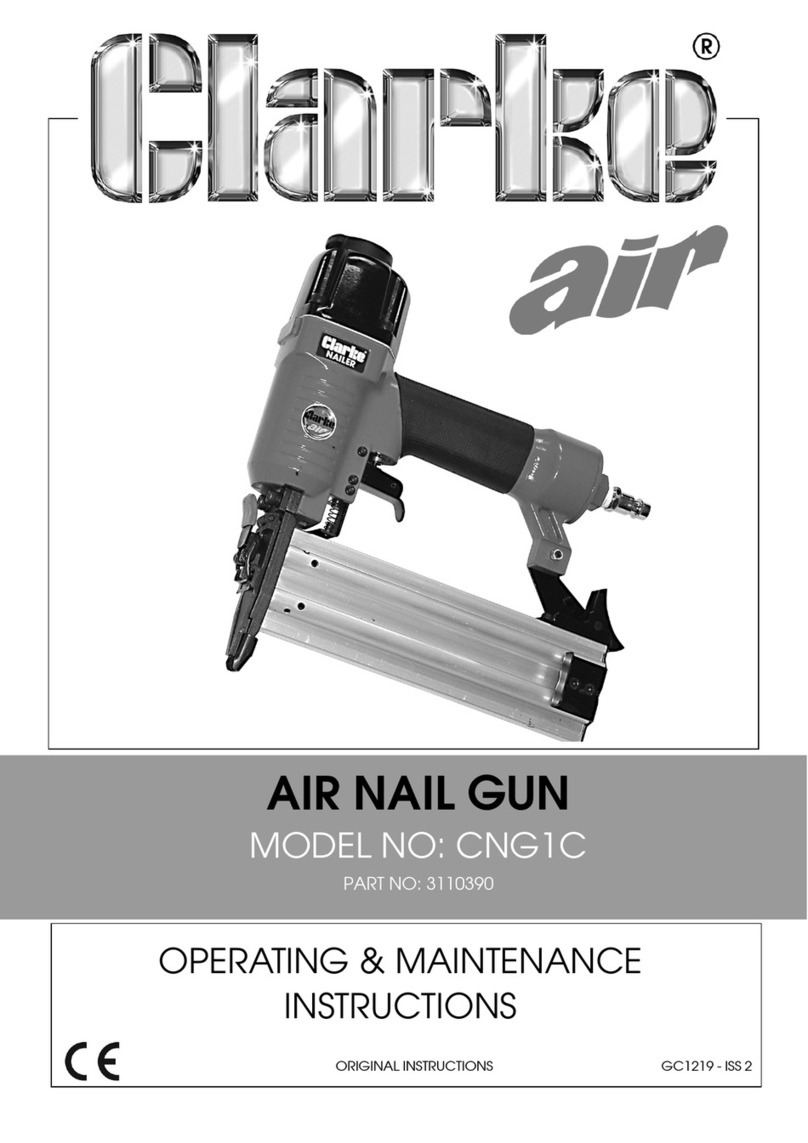
Clarke
Clarke CNG1C Operating & maintenance instructions
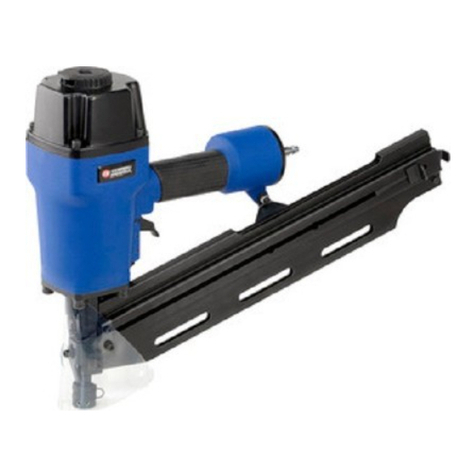
Campbell Hausfeld
Campbell Hausfeld IN715703AV operating instructions

Parkside
Parkside PET 25 A1 Operation and safety notes
